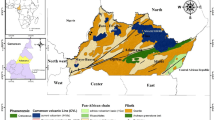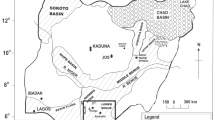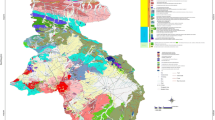Abstract
Prospecting the geothermal resources in northwest of Iran, conducted in 1975, revealed several promising areas and introduced the Sabalan geothermal field as a priority for further studies. The Sabalan Mt., representing the Sabalan geothermal field, is a large stratovolcano which consists of an extensive central edifice built on a probable tectonic horst of underlying intrusive and effusive volcanic rocks. In this study, Curie point depth (CPD), geothermal gradient and heat-flow map were constituted from spectral analysis of the aeromagnetic data for the NW of Iran. The top of the geothermal resource (i.e., the thickness of the overburden) was evaluated by applying the Euler deconvolution method on the residual gravity data. The thickness of the geothermal resource was calculated by subtracting the Euler depths obtained from the CPDs in the geothermal anomalous region. The geothermal anomalous region was defined by the heat-flow value greater than 150 mW/m2. CPDs in the investigated area are found between 8.8 km in the Sabalan geothermal field and 14.1 in the northeast. The results showed that the geothermal gradient is higher than 62 °C/km and the heat-flow is higher than 152 mW/m2 for the geothermal manifestation region; the thickness of the geothermal resource was also estimated to vary between 5.4 and 9.1 km. These results are consistent with the drilling and other geological information. Findings indicate that the CDPs agree with earthquake distribution and the type of thermal spring is related to the depth of the top of the geothermal resource.

Modified after Azad et al. (2011)

Modified from Amini (1998)











(Modified after Noorollahi and Itoi, 2011)

Similar content being viewed by others
References
Aboud, E., Salem, A., & Mekkawi, M. (2011). Curie depth map for Sinai Peninsula, Egypt deduced from the analysis of magnetic data. Tectonophysics, 506(1), 46–54.
Alavi, M. (1994). Tectonics of the Zagros orogenic belt of Iran: New data and interpretations. Tectonophysics, 229(3), 211–238.
Amini. (1998). Meshkin Shahr geological map in scale of 1/100000. GSI, Iran.
Amirpour-asl, A., Ghods, A., Rezaeian, M., & Bahroudi, A. (2010). Depth of Curie temperature isotherm from aeromagnetic spectra in Iran: Tectonic implication, Tectonic crossroads: Evolving Orogens of Eurasia–Africa–Arabia, Ankara, Turkey.
Aydin, I., & Oksum, E. (2010). Exponential approach to estimate the Curie-temperature depth. Journal of Geophysics and Engineering, 7, 113–125.
Azad, S. S., Dominguez, S., Philip, H., Hessami, K., Forutan, M. R., Zadeh, M. S., et al. (2011). The Zandjan fault system: Morphological and tectonic evidences of a new active fault network in the NW of Iran. Tectonophysics, 506(1), 73–85.
Bansal, A., Anand, S., Rajaram, M., Rao, V., & Dimri, V. (2013). Depth to the bottom of magnetic sources (DBMS) from aeromagnetic data of Central India using modified centroid method for fractal distribution of sources. Tectonophysics, 603, 155–161.
Bansal, A., Gabriel, G., Dimri, V., & Krawczyk, C. (2011). Estimation of depth to the bottom of magnetic sources by a modified centroid method for fractal distribution of sources: An application to aeromagnetic data in Germany. Geophysics, 76(3), L11–L22.
Baroň, I., Kernstocková, M., Faridi, M., Bubík, M., Milovský, R., Melichar, R., et al. (2013). Paleostress analysis of a gigantic gravitational mass movement in active tectonic setting: The Qoshadagh slope failure, Ahar, NW Iran. Tectonophysics, 605, 70–87.
Bektaş, Ö. (2013). Thermal structure of the crust in Inner East Anatolia from aeromagnetic and gravity data. Physics of the Earth and Planetary Interiors, 221, 27–37.
Bektaş, Ö., Ravat, D., Büyüksaraç, A., Bilim, F., & Ateş, A. (2007). Regional geothermal characterisation of East Anatolia from aeromagnetic, heat flow and gravity data. Pure and Applied Geophysics, 164(5), 975–998.
Bhattacharyya, B., & Leu, L. K. (1975). Analysis of magnetic anomalies over Yellowstone National Park: Mapping of Curie point isothermal surface for geothermal reconnaissance. Journal of Geophysical Research, 80(32), 4461–4465.
Bhattacharyya, B., & Leu, L. K. (1977). Spectral analysis of gravity and magnetic anomalies due to rectangular prismatic bodies. Geophysics, 42(1), 41–50.
Bilim, F., Akay, T., Aydemir, A., & Kosaroglu, S. (2016). Curie point depth, heat-flow and radiogenic heat production deduced from the spectral analysis of the aeromagnetic data for geothermal investigation on the Menderes Massif and the Aegean Region, western Turkey. Geothermics, 60, 44–57.
Blakely, R. J. (1988). Curie temperature isotherm analysis and tectonic implications of aeromagnetic data from Nevada. Journal of Geophysical Research: Solid Earth (1978–2012), 93(B10), 11817–11832.
Blakely, R. J. (1996). Potential theory in gravity and magnetic applications. Cambridge University Press, Cambridge, UK.
Bogie, I., Khosrawi, K., & Talebi, B. (2005). Geological results from the drilling of the Northwest Sabalan geothermal project, Iran. In Proceedings of the world Geothermal Congress, Antalya, Turkey, 1–5 April 2005.
Bromley, C., Khosrawi, K., & Talebi, B. (2000). Geophysical exploration of Sabalan geothermal prospects in Iran. In Proceedings of the world Geothermal Congress, Kyushu - Tohoku, Japan, May- June 2010.
Chavez, R. (1987). An integrated geophysical study of the geothermal field of Tule Chek, BC, Mexico. Geothermics, 16(5), 529–538.
Chen, Z., Mou, L., & Meng, X. (2016). The horizontal boundary and top depth estimates of buried source using gravity data and their applications. Journal of Applied Geophysics, 124, 62–72.
Comin-Chiaramonti, P., Meriani, S., Mosca, R., & Sinigoi, S. (1979). On the occurrence of analcime in the northeastern Azerbaijan volcanics (northwestern Iran). Lithos, 12(3), 187–198.
Connard, G., Couch, R., & Gemperle, M. (1983). Analysis of aeromagnetic measurements from the Cascade Range in central Oregon. Geophysics, 48(3), 376–390.
Didon, J., & Germain, Y. M. (1976). Le Sabalan, Volcan Plio-Quaternaire de l Azerbaidjan oriental (Iran): Etude geologique et petrographique de le difice et de son environment regional. Grenoble: Université de Grenoble.
Dolmaz, M., Hisarli, Z., Ustaömer, T., & Orbay, N. (2005). Curie point depths based on spectrum analysis of aeromagnetic data, West Anatolian extensional province, Turkey. Pure and Applied Geophysics, 162(3), 571–590.
Finn C. A., & Ravat, D. (2004). Magnetic depth estimates and their potential for constraining crustal composition and heat flow in Antarctica. EOS Transactions American Geophysical Union, Fall Meeting Abstracts, 1 December 2004.
Fotouhi, M. (1995). Geothermal development in Sabalan, Iran. In Proceedings of the World Geothermal Congress 1995, Florence, Italy, pp. 191–196.
Ghaedrahmati, R., Moradzadeh, A., Fathianpour, N., Lee, S. K., & Porkhial, S. (2013). 3-D inversion of MT data from the Sabalan geothermal field, Ardabil, Iran. Journal of Applied Geophysics, 93, 12–24.
Guo, L., Meng, X., Chen, Z., Li, S., & Zheng, Y. (2013). Preferential filtering for gravity anomaly separation. Computers & Geosciences, 51, 247–254.
Hsieh, H. H., Chen, C. H., Lin, P. Y., & Yen, H. Y. (2014). Curie point depth from spectral analysis of magnetic data in Taiwan. Journal of Asian Earth Sciences, 90, 26–33.
Innocenti, F., Mazzuoli, R., Pasquarè, G., Radicati Di Brozolo, F., & Villari, L. (1982). Tertiary and quaternary volcanism of the Erzurumkars area (Eastern Turkey): Geochronological data and geodynamic evolution. Journal of Volcanology and Geothermal Research, 13(3–4), 223–240.
Khalil, M. A., Santos, F. M., & Farzamian, M. (2014). 3D gravity inversion and Euler deconvolution to delineate the hydro-tectonic regime in El-Arish area, northern Sinai Peninsula. Journal of Applied Geophysics, 103, 104–113.
Khojamli, A., Ardejani, F. D., Moradzadeh, A., Kalate, A. N., Kahoo, A. R., & Porkhial, S. (2016). Estimation of Curie point depths and heat flow from Ardebil province, Iran, using aeromagnetic data. Arabian Journal of Geosciences, 9(5), 1–11.
Khojamli, A., Doulati Ardejani, F., Moradzadeh, A., Nejati Kalateh, A., Roshandel Kahoo, A., & Porkhial, S. (2015). Determining fractal parameter and depth of magnetic sources for ardabil geothermal area using aeromagnetic data by de-fractal approach. Journal of Mining and Environment. doi:10.22044/jme.2015.481 (In press).
Kıyak, A., Karavul, C., Gülen, L., Pekşen, E., & Kılıç, A. R. (2015). Assessment of geothermal energy potential by geophysical methods: Nevşehir Region, Central Anatolia. Journal of Volcanology and Geothermal Research, 295, 55–64.
KML. (1998). Sabalan geothermal project, stage 1-surface exploration, final exploration report. Report number. 2505-RPT-GE-003.
Li, Y., & Oldenburg, D. W. (1998). Separation of regional and residual magnetic field data. Geophysics, 63(2), 431–439.
Maden, N. (2010). Curie-point depth from spectral analysis of magnetic data in Erciyes stratovolcano (Central Turkey). Pure and Applied Geophysics, 167(3), 349–358.
Maus, S., & Dimri, V. (1996). Depth estimation from the scaling power spectrum of potential fields. Geophysical Journal International, 124(1), 113–120.
Maus, S., Gordon, D., & Fairhead, D. (1997). Curie-temperature depth estimation using a self-similar magnetization model. Geophysical Journal International, 129(1), 163–168.
Moghaddam, M. K., Samadzadegan, F., Noorollahi, Y., Sharifi, M. A., & Itoi, R. (2014). Spatial analysis and multi-criteria decision making for regional-scale geothermal favorability map. Geothermics, 50, 189–201.
Mousavi, Z., Darvishzadeh, A., Ghalamghas, J., & Abedini, M. V. (2011). Discussion on stratigraphy questions at Sabalan volcano and Sabalan geothermal exploration project, Meshkinshahr, Iran. GRC Transactions, 35, 931–934.
Nabi, E., & Abd, S. H. (2012). Curie point depth beneath the Barramiya-Red Sea coast area estimated from spectral analysis of aeromagnetic data. Journal of Asian Earth Sciences, 43(1), 254–266.
Nagata, T. (1961). Rock magnetism (2nd ed., p. p350). Tokyo: Maruzen.
Noorollahi, Y., & Itoi, R. (2011). Production capacity estimation by reservoir numerical simulation of northwest (NW) Sabalan geothermal field, Iran. Energy, 36(7), 4552–4569.
Nouraliee, J., Porkhial, S., Mohammadzadeh-Moghaddam, M., Mirzaei, S., Ebrahimi, D., & Rahmani, M. (2015). Investigation of density contrasts and geologic structures of hot springs in the Markazi Province of Iran using the gravity method. Russian Geology and Geophysics, 56(12), 1791–1800.
Nwankwo, L. I. (2015). Estimation of depths to the bottom of magnetic sources and ensuing geothermal parameters from aeromagnetic data of Upper Sokoto Basin, Nigeria. Geothermics, 54, 76–81.
Nwankwo, L. I., & Shehu, A. T. (2015). Evaluation of Curie-point depths, geothermal gradients and near-surface heat flow from high-resolution aeromagnetic (HRAM) data of the entire Sokoto Basin, Nigeria. Journal of Volcanology and Geothermal Research, 305, 45–55.
Obande, G. E., Lawal, K. M., & Ahmed, L. A. (2014). Spectral analysis of aeromagnetic data for geothermal investigation of Wikki Warm Spring, north-east Nigeria. Geothermics, 50, 85–90.
Okubo, Y., Graf, R., Hansen, R., Ogawa, K., & Tsu, H. (1985). Curie point depths of the island of Kyushu and surrounding areas, Japan. Geophysics, 50(3), 481–494.
Philip, H., Avagyan, A., Karakhanian, A., Ritz, J. F., & Rebai, S. (2001). Estimating slip rates and recurrence intervals for strong earthquakes along an intracontinental fault: example of the Pambak–Sevan–Sunik fault (Armenia). Tectonophysics, 343(3), 205–232.
Rao, C. R., Kishore, R., Kumar, V. P., & Babu, B. B. (2011). Delineation of intra crustal horizon in Eastern Dharwar Craton—an aeromagnetic evidence. Journal of Asian Earth Sciences, 40(2), 534–541.
Ravat, D., Pignatelli, A., Nicolosi, I., & Chiappini, M. (2007). A study of spectral methods of estimating the depth to the bottom of magnetic sources from near-surface magnetic anomaly data. Geophysical Journal International, 169(2), 421–434.
Rebai, S., Philip, H., Dorbath, L., Borissoff, B., Haessler, H., & Cisternas, A. (1993). Active tectonics in the Lesser Caucasus: Coexistence of compressive and extensional structures. Tectonics, 12(5), 1089–1114.
Reid, A., Allsop, J., Granser, H., Millett, A., & Somerton, I. (1990). Magnetic interpretation in three dimensions using Euler deconvolution. Geophysics, 55(1), 80–91.
Reid, A. B., Ebbing, J., & Webb, S. J. (2014). Avoidable Euler errors—the use and abuse of Euler deconvolution applied to potential fields. Geophysical Prospecting, 62(5), 1162–1168.
Riou, R., Dupuy, C., & Dostal, J. (1981). Geochemistry of coexisting alkaline and calc-alkaline volcanic rocks from northern Azerbaijan (N.W. Iran). Journal of Volcanology and Geothermal Research, 11(2), 253–275.
Rolland, Y., Sosson, M., Adamia, S., & Sadradze, N. (2011). Prolonged Variscan to Alpine history of an active Eurasian margin (Georgia, Armenia) revealed by 40 Ar/39 Ar dating. Gondwana Research, 20(4), 798–815.
Ross, H. E., Blakely, R. J., & Zoback, M. D. (2006). Testing the use of aeromagnetic data for the determination of Curie depth in California. Geophysics, 71(5), L51–L59.
Saibi, H., Aboud, E., & Gottsmann, J. (2015). Curie point depth from spectral analysis of aeromagnetic data for geothermal reconnaissance in Afghanistan. Journal of African Earth Sciences, 111, 92–99.
Salem, A., Green, C., Ravat, D., Singh, K. H., East, P., Fairhead, J. D., et al. (2014). Depth to Curie temperature across the central Red Sea from magnetic data using the de-fractal method. Tectonophysics, 624, 75–86.
Selim, S. E. I., & Aboud, E. (2014). Application of spectral analysis technique on ground magnetic data to calculate the Curie depth point of the eastern shore of the Gulf of Suez, Egypt. Arabian Journal of Geosciences, 7(5), 1749–1762.
Shahbazi Shiran, H. (2013). Petrogenesis of quaternary shoshonitic volcanism in NE Iran (Ardabil): Implication for postcollisional magmatism. Journal of Geological Research, 2013, 11.
Shuey, R., Schellinger, D., Tripp, A., & Alley, L. (1977). Curie depth determination from aeromagnetic spectra. Geophysical Journal International, 50(1), 75–101.
SKM. (2005). Resource review of the Northwest Sabalan geothermal project. Report submitted to SUNA, Iran.
Smith, R., Shuey, R., Pelton, J., & Bailey, J. (1977). Yellowstone hot spot: Contemporary tectonics and crustal properties from earthquake and aeromagnetic data. Journal of Geophysical Research, 82(26), 3665–3676.
Spector, A., & Grant, F. (1970). Statistical models for interpreting aeromagnetic data. Geophysics, 35(2), 293–302.
Springer, M. (1999). Interpretation of heat-flow density in the Central Andes. Tectonophysics, 306(3), 377–395.
Starostenko, V. I., Dolmaz, M. N., Kutas, R. I., Rusakov, O. M., Oksum, E., Hisarli, Z. M., et al. (2014). Thermal structure of the crust in the Black Sea: Comparative analysis of magnetic and heat flow data. Marine Geophysical Research, 35(4), 345–359.
Stavrev, P. Y. (1997). Euler deconvolution using differential similarity transformations of gravity or magnetic anomalies. Geophysical Prospecting, 45(2), 207–246.
Tanaka, A., Okubo, Y., & Matsubayashi, O. (1999). Curie point depth based on spectrum analysis of the magnetic anomaly data in East and Southeast Asia. Tectonophysics, 306(3), 461–470.
Telford, W. M., Geldart, L. P., & Sheriff, R. E. (1990). Applied geophysics, Cambridge University Press, Cambridge, UK.
Thompson, D. (1982). EULDPH: A new technique for making computer-assisted depth estimates from magnetic data. Geophysics, 47(1), 31–37.
Trifonova, P., Zhelev, Z., Petrova, T., & Bojadgieva, K. (2009). Curie point depths of Bulgarian territory inferred from geomagnetic observations and its correlation with regional thermal structure and seismicity. Tectonophysics, 473(3), 362–374.
Wright, P. M., Ward, S. H., Ross, H. P., & West, R. C. (1985). State-of-the-art geophysical exploration for geothermal resources. Geophysics, 50(12), 2666–2699.
Acknowledgements
The authors would like to appreciate the generosity of Renewable Energy Organization of Iran (SUNA) authorities for providing the gravity and aeromagnetic data used in this study. The authors are also grateful to the Geophysics lab of School of Mining Engineering of University of Tehran for the facilities made available for the research work. The Editor of the Pure and Applied Geophysic Journal, Dr. Hans-Jürgen Götze, Solid Earth Sciences, and an anonymous referee are also appreciated for their constructive and valuable comments which helped to improve the quality of this work.
Author information
Authors and Affiliations
Corresponding author
Rights and permissions
About this article
Cite this article
Afshar, A., Norouzi, G.H., Moradzadeh, A. et al. Curie Point Depth, Geothermal Gradient and Heat-Flow Estimation and Geothermal Anomaly Exploration from Integrated Analysis of Aeromagnetic and Gravity Data on the Sabalan Area, NW Iran. Pure Appl. Geophys. 174, 1133–1152 (2017). https://doi.org/10.1007/s00024-016-1448-z
Received:
Revised:
Accepted:
Published:
Issue Date:
DOI: https://doi.org/10.1007/s00024-016-1448-z





